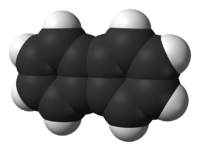Biphenylene
 |
|
 |
|
| Names | |
|---|---|
|
Preferred IUPAC name
Biphenylene
|
|
| Other names
Diphenylene (no longer recommended)
|
|
| Identifiers | |
|
3D model (JSmol)
|
|
| ChEBI | |
| ChemSpider | |
| ECHA InfoCard | 100.217.287 |
|
PubChem CID
|
|
|
|
|
|
| Properties | |
| C12H8 | |
| Molar mass | 152.19 g/mol |
| Appearance | solid |
| Melting point | 109 to 111 °C (228 to 232 °F; 382 to 384 K) |
| Related compounds | |
|
Related unsaturated
hydrocarbons |
benzene cyclobutene cyclobutadiene |
|
Except where otherwise noted, data are given for materials in their standard state (at 25 °C [77 °F], 100 kPa).
|
|
|
|
|
| Infobox references | |
Biphenylene is an alternant, polycyclic hydrocarbon composed of two benzene rings joined together by a pair of mutual attachments (as opposed to a normal ring fusion), thus forming a 6-4-6 arene system. The resulting planar structure was one of the first pi-electronic hydrocarbon systems discovered to show evidence of antiaromaticity.
The biphenylene structure can also be understood as a dimer of the reactive intermediate benzyne, which in fact serves as a major synthetic route, by heating the benzenediazonium-2-carboxylate zwitterion prepared from 2-aminobenzoic acid. Another approach is by N-amination of 1H-benzotriazole with hydroxylamine-O-sulfonic acid. The major product, 1-aminobenzotriazole, forms benzyne in an almost quantitative yield by oxidation with lead(IV) acetate, which rapidly dimerises to biphenylene in good yields.
Biphenylene, a pale yellowish solid with a hay-like odor, was first synthesized by Lothrop in 1941. The chemistry of biphenylene is extensive, and has been the subject of two major reviews., Biphenylene is quite stable both chemically and thermally, and behaves in many ways like a traditional polycyclic aromatic hydrocarbon. However, both the spectral and chemical properties show the influence of the central [4n] ring, leading to considerable interest in the system in terms of its degree of lessened aromaticity.
Questions of bond alternation and ring currents have been investigated repeatedly. Both X-ray diffraction and electron diffraction studies show a considerable alternation of bond lengths, with the bridging bonds between the benzenoid rings having the unusually great length of 1.524 Å. The separation of the rings is also reflected by the absence of the transmission of NMR substituent effects through the central [4n] ring. However, more sensitive NMR evidence, and particularly the shifting of proton resonances to high field, does indicate the existence of electron delocalization in the central [4n] ring., This upfield shift has been interpreted in terms of diminished benzenoid ring currents, either with or without an accompanying paramagnetic ring current in the central [4n] ring. Magnetic susceptibility measurements also show a diminishing of both diamagnetic exaltation and diamagnetic anisotropy, relative to comparable pure [4n+2] systems, which is also consistent with a reduction of ring current diamagnetism. The electronic structure of biphenylene in the gas phase has the HOMO at a binding energy of 7.8 eV.
...
Wikipedia
